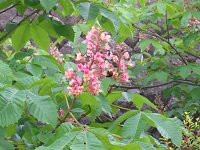
As we were about to exit our 11th-floor apartment, we suddenly felt the building sway slightly beneath our feet and heard the rhythmic rattle of an interior door against its metal latchhook. We retreated back into our doorway, nervous but confident that the newly constructed Japanese high-rise could withstand an earthquake that had not even caused us to lose our footing. Nor had it caused any visible panic in the streets of
Ashikaga far below.
It was Tuesday, the 16th of August, and we were just setting out on a complex, minutely scheduled multi-train itinerary that would have us reaching Tokyo station in time to transfer to the same Narita airport express train that an old friend coming up from Osaka was booked on, so that both she and we could meet her daughter who was due to overnight in Narita on her way back from Auckland to London for university. We were all scheduled to arrive by train at 16:25, just about the time she would be clearing customs.
We would all have just enough time to eat a traditional Japanese meal together at the airport hotel before dispersing in three different directions to spend that night: our friends staying at the hotel, my wife going back to Ashikaga for school business the next day, and my daughter and I going to our friend's parents' house on the west side of Tokyo so we could spend a little more time catching up the next day.
The first leg of the familiar local train ride from Ashikaga to the nearest bullet train (Shinkansen) station at Oyama gave no hint of any major disruption. Nor did the man who booked our seat reservations for the remainder of the trip. But almost as soon as we headed for the Shinkansen platform, they started turning people away, saying the Northeast Shinkansen (through Sendai) had been shut down. We had no idea why until the station announcements began blaming the earthquake. We were forced to hop on a slow local train bound for Ueno station in Tokyo.
Fortunately, we had gotten an early start in order to have time to book seat reservations, so we still had a chance to make the 15:33 Narita Express (N'EX) from Tokyo. But the sprawling Tokyo Shinkansen station was a complete mess, with no reliable timetables, repeated announcements of delays, and stranded passengers all over the place in the peak summer travel season.
At 15:33, the Narita Express platform was still listing the train scheduled for 14:33, with no indication of the actual times for any of the delayed trains. The harried platform officials assured us that seat reservations no longer mattered, that we could climb aboard any N'EX that came by. So we did, and sure enough, no one on board bothered to check our seat assignments.
We got to the airport close to 17:00, wondering how to get in touch with our friends. We went first to the arrival area outside customs, and were shocked almost immediately to run into our friend from Osaka, who had arrived on the same train we had and was waiting for her daughter's flight to clear customs. It had been delayed, too--but not by an earthquake!
We had a very pleasant dinner, imagining that the world-famous Shinkansen system was quickly getting back on schedule. When we dispatched my wife, who knows hardly any Japanese, back to the Narita Express station, we had no idea what we had condemned her to. The N'EX had canceled most of its runs, so she had to take a series of slower trains all the way back to Ashikaga, arriving home about midnight.
An hour after my wife left, my daughter and I headed for a N'EX that was supposed to go all the way to
Kokubunji on the west side of Tokyo, where our hosts for the night expected us to show up pretty late anyway. But that train was canceled, so we were instead put on a bus for Shinjuku, the major west-side transfer station. As it happened, the bus got to Shinjuku early enough to allow us to jump on a commuter express that got us into Kokubunji much faster than either we or our hosts had expected.
The northbound Shinkansen was
still snarled the next evening when we headed back to Ashikaga, but all the local trains and buses provided a very effective--if slower--backup system.
 Tochigi Prefecture, in which Ashikaga is located, is named after 栃の木 (tochi-no-ki), the Japanese horse chestnut, Aesculus turbinata Blume, a close relative of the Ohio buckeye, Aesculus glabra, and the European horse chestnut, Aesculus hippocastanum L. Marronnier, the French name for horse chestnut shows up in would-be glamorous commercial names here and there in the prefecture. I've seen it in Nikko, Utsunomiya, and Ashikaga. For some reason, "Horse Chestnut" does not seem to have the same appeal, or at least I've yet to see it in our Tochigi travels.
Tochigi Prefecture, in which Ashikaga is located, is named after 栃の木 (tochi-no-ki), the Japanese horse chestnut, Aesculus turbinata Blume, a close relative of the Ohio buckeye, Aesculus glabra, and the European horse chestnut, Aesculus hippocastanum L. Marronnier, the French name for horse chestnut shows up in would-be glamorous commercial names here and there in the prefecture. I've seen it in Nikko, Utsunomiya, and Ashikaga. For some reason, "Horse Chestnut" does not seem to have the same appeal, or at least I've yet to see it in our Tochigi travels.



